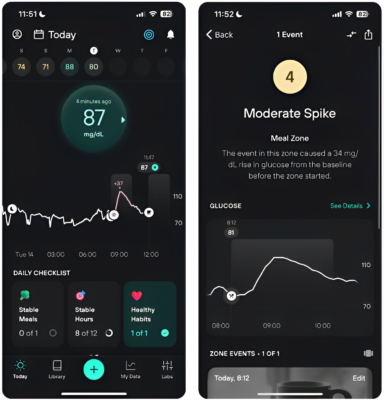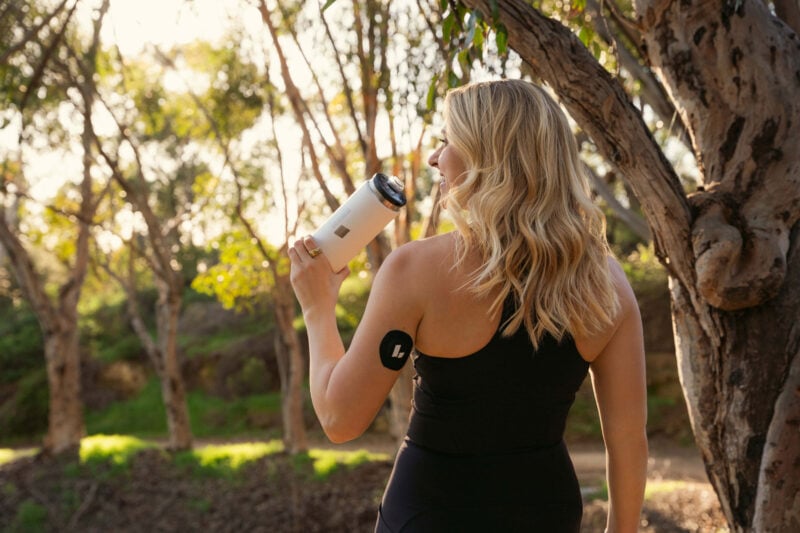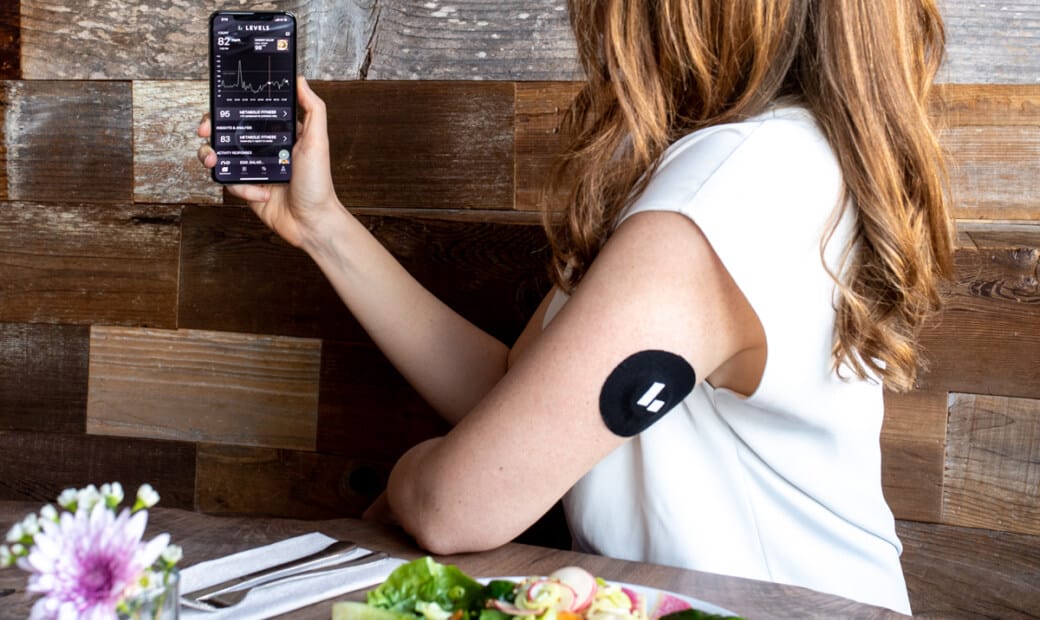Food, exercise, sleep, stress, and other lifestyle factors can all impact our blood glucose. While you may feel these changes—you crash midmorning after a high-carb breakfast—the best way to know for sure what affects your blood sugar and how is to use a continuous glucose monitor (CGM).
Why does glucose matter? It’s the key to metabolic health. Because blood glucose is our cells’ primary source of energy, erratic blood sugar levels can lead to various health problems, including fatigue and brain fog in the short term and weight gain, Type 2 diabetes, dementia, and heart disease in the long term. Often, many of us don’t realize how much our blood glucose levels sway. In a 2018 study, about half the participants who had “normal” glucose levels experienced post-meal glucose levels in the prediabetic or diabetic range after at least one of the following meals: cornflakes with milk, a peanut butter sandwich, or a protein bar. Tracking with a CGM can help you identify these kinds of spikes and learn to prevent them.
CGMs were initially created to help people with diabetes keep their blood sugar in a healthy range and can be lifesaving devices for these people. But for people trying to prevent diabetes and prediabetes and just feel better day-to-day, using a CGM delivers real-time data that can help you identify patterns in your health and make smarter adjustments. Here’s how to get started and make the most of this tool, given your health goals.
How to get a CGM
You need a prescription to obtain a CGM in the U.S. (though not in Canada and Europe). If you haven’t been diagnosed with diabetes, you can still ask your doctor for a prescription (which you can fulfill at most pharmacies), or you can work with a company like Levels. Companies like ours typically require you to answer a medical questionnaire, which is reviewed asynchronously by a telehealth physician licensed in your state to determine if you’re eligible for a CGM. If so, they write a prescription and send it to one of the CGM program’s partner pharmacies, and the CGM is shipped to your door.
What is a CGM, and how does it work?
A continuous glucose monitor is a biosensor that you wear to get data about your blood glucose level in real time.
Although each CGM is slightly different, all have two basic components:
- A sensor, which typically goes on the back of your arm or stomach
- A way to read the data

The sensor is often about the size of two stacked quarters. It has adhesive to stick to your skin and a small flexible filament (less than a quarter-inch long and about as thick as dental floss). This fiber is coated with an enzyme, and the end sits in the interstitial fluid just below your skin. There, the enzyme (glucose oxidase) triggers a reaction: It breaks down glucose into multiple molecules, including hydrogen peroxide, which then reacts with a metal (typically platinum) inside the sensor to break down into hydrogen, oxygen, and electrons. This generates a current that’s converted into a glucose concentration number.
The CGM then wirelessly sends this data to an app or other device, where it’s displayed in milligrams per deciliter (mg/dL), typically on a chart so you can see changes over time.
Note that the reading is not exactly real-time. Most CGMs take readings every few minutes, and the glucose concentration in your interstitial fluid can lag your blood glucose by 10-15 minutes (since it takes time for glucose to seep out of your blood). But doctors consider CGMs accurate enough for people with diabetes to dose insulin, so they are plenty accurate for health optimization.
What to know when you first start using a CGM
The first step in using a CGM is applying it:
- Clean the area where you’re going to apply it with an alcohol wipe. (To reduce skin irritation, avoid using the same injection site twice a row. Also, avoid locations with tattoos, moles, or scars.) Let your skin fully dry so the sensor will stick properly.
- Place the applicator on the site and follow the manufacturer’s directions to insert the sensor. When you press the applicator against your skin, a tiny, spring-loaded needle guides the small sensor through your skin and retreats. The end of the filament remains, sitting just below your skin. This process is quick and typically painless. However, some people may feel a pinch or be sore around the injection site for a few hours.
Once the sensor is on, you can go about your regular activities. It’s OK to shower, swim, sleep, and do anything else while wearing a CGM. However, you may want to wear a protective performance cover to keep any moisture out and ensure your CGM stays in place.
If you swim, note that CGMs are water-resistant to a point. For example, some sensors work underwater up to three feet deep for up to 30 minutes. Check the manufacturer’s website.
CGMs typically last around 10–14 days, depending on the model. Over time, the body’s reaction to the small puncture and the filament chemistry degrade their accuracy. When the sensor is finished, you simply peel it off, throw it away and apply a new one.
For many people, a month is enough time to become accustomed to learning from a CGM and to turn the data into lifestyle changes that benefit their metabolic health. Consider this schedule:
- Week 1: It can take a day or two for your CGM to calibrate and give you the most accurate readings. So, for the first week, focus on getting in the habit of logging your food in the app and checking how your blood glucose reacts, but don’t get too concerned over absolute values—just watch directional trends.
- Week 2: Maintain your regular diet and see how your body responds. Which meals or foods trigger blood sugar spikes, and which trigger more gradual responses? “Some of my patients unconsciously begin to eat ‘better’ when they first put on a CGM,” says Anjali Dsouza, MD, founder of the District Center for Integrative Medicine. “That’s perfectly fine, but the juicy insights come when you don’t and can figure out what things, combinations of things, and contextual things will bring about spikes so you can incorporate that knowledge into your life to improve your health outcomes.”
- Week 3: Now’s the time to start experimenting to see if you can find ways to promote more stable blood glucose. Maybe you go for short walks after meals, swap your breakfast oatmeal for chia seed pudding, and add more quality protein to the beginning of every meal. Pick a few things you can realistically do for seven full days, and note what makes a positive impact.
- Week 4: Review the past week to identify which changes you can maintain benefited you most. Try to use those insights to maintain optimal glucose for an entire week.
How to interpret your CGM data
You can use the information from your CGM to personalize your nutrition, exercise, sleep, and more to reach your metabolic health goals. While each CGM has its own simple app to show you your raw glucose numbers, apps like Levels help you make sense of that data—connecting it to behavior and learning what to do about it.
Let’s look at the Levels app as an example.

- The Current Glucose score (the large number at the top center) is your real-time blood glucose in milligrams per deciliter.
- The graph underneath is your Glucose Graph. This shows how your blood glucose fluctuates throughout the day (called glycemic variability). You can see previous days to compare your data over time. Although your glycemic variability will change during the day, overall, the goal is low variability. Frequent spikes and falls in blood glucose (and, as a result, insulin) are associated with an increased risk of insulin resistance, heart disease, diabetes, and metabolic dysfunction.
- Under this, you’ll see Stable Meals, Stable Hours, and Healthy Habits scores. Together, these help motivate you to stick to habits that support your metabolic health. You’re aiming for things like completing a meal with a Zone Score of at least 7 [see below], maintaining at least 12 consecutive hours of stable glucose each day, and getting at least seven hours of sleep or doing at least one physical activity.
- Zone Scores indicate how foods and activities affect your blood sugar levels. How quickly and how much your glucose rises in the two-hour window following a meal determines your Zone Score. Regular scores of 7 and higher (on a scale of 1-10) typically indicate that your habits are supporting good metabolic health. If you have lower scores, you could benefit from changes such as adding fiber, healthy fat, and protein to meals and swapping high-carb foods (like white pasta) for lower-carb alternatives (like zucchini noodles).
The goal isn’t a pancake-flat Glucose Graph and a Zone Score of 10 for every meal. That’s unrealistic—fluctuations are 100 percent normal. So try not to obsess over any numbers or freak out about every rise, particularly fairly small ones that look like rolling hills. Our bodies can handle glucose, breaking it down into the fuel our cells need to function properly or storing it for later. The goal is long-term health improvement, not “beating the app” on a given day.
In general, based on our read of the current research on glucose levels in people without diabetes and the perspective of our expert advisors, we recommend aiming for the following targets for optimal health (note these are slightly lower than what’s considered “normal” by groups like American Diabetes Association and the International Diabetes Federation.)
- Fasting glucose levels: between 72–85 mg/dL
- 24-hour mean glucose levels: around 79–100 mg/dL
- Mean post-meal glucose peaks: <110 mg/dL, with <30 mg/dL increase from pre-meal levels
Additionally, glucose levels should stay between 70 and 110 mg/dL for approximately 90 percent of the day (and rarely go above 140 mg/dL or below 60 mg/dL).
Use all the data from your CGM as a tool to minimize frequent or significant blood glucose spikes. Examine any individual spikes with curiosity, not criticism. For example, for people who menstruate, the phase of your cycle can impact your blood glucose. So can sleep and stress. You may discover other insights, such as:
- How to dampen the glucose response of some of your favorite higher-carb meals by eating something rich in protein or fat—such as a handful of almonds or a small, plain Greek yogurt—beforehand.
- Delicious swaps for dishes that trigger a spike. The Levels app offers personalized alternatives of similar recipes to support better metabolic health. (Say, a cauliflower-rice-based burrito bowl rather than one built on quinoa.)
- The realization that your afternoon slump is caused by your high-carb lunch order, which causes your blood sugar to rise rapidly and then sharply plummet.
- How one night of poor sleep can cause higher-than-normal glucose levels.
- Whether your blood sugar tends to increase overall during periods of stress and ways to manage your mental health.
This real-time feedback puts you in control. You can experiment with food, exercise, and other lifestyle changes and quickly see which ones lead to more stable blood sugar—and, as a result, likely more energy, better sleep, improved focus, and good metabolic health.
Keep in mind, if using a CGM causes anxiety or obsessive thoughts, it may not be the right tool for you. Similarly, if you have a history of disordered eating or anxiety around food or exercise, we encourage working with a mental health professional before using a device like a CGM.
How do you use CGM in the long term?
Metabolic health isn’t a quick hack, and it isn’t only about blood glucose. Just as one spike isn’t the end of the world, one day of stable glucose isn’t the win. The goal is to learn how to support holistic health in the long run. That’s why Levels tracks several metrics (including average glucose, stable hours, and sleep) in the app for up to 90 days so you can see trends.
With that information, you can find diet, exercise, and other changes that support stable glucose and that you can maintain—enjoyably—for life. A CGM may help benefit you in many ways, such as the following.
(Note: Levels and other CGMs help optimize your lifestyle and health. They are not for medical applications. If you have any specific health concerns when using the device, consult a doctor.)
Helping you create your personal best diet.
Our metabolic responses to foods are highly individual. Even foods that tend to be labeled “healthy”—like sweet potatoes, quinoa, and oats—may cause your blood sugar to spike but have no impact on your partner’s blood sugar. Everything from our genetics and microbiome to our overall fitness and stress levels appear to play a role in glucose response. Only a CGM can provide a detailed, specific picture of your unique reaction to foods, giving you the power to affect your health.
Improving metabolic flexibility.
Our bodies prefer to burn either glucose or fat for fuel. How efficiently your body switches between these two sources is called your metabolic flexibility. Being metabolically inflexible is associated with insulin resistance, Type 2 diabetes, and obesity. On the other hand, if your metabolic flexibility is good, your body will more easily tap into fat stores for energy if you use up all the glucose available from food and stored glycogen. (For example, if you perform fasted exercise.) You can become more metabolically flexible by maintaining more stable blood sugar. And your CGM can help you with this goal.
Managing weight.
If you’re struggling to meet your goal weight, a CGM may help. For one, high levels of insulin are associated with weight gain. Learning how to balance your blood sugar may lead to changes on the scale. Additionally, a continuous glucose monitor helps you find what works—and what doesn’t—for you. Rather than trying to stick to a rigid (and often unrealistic) diet plan, you can create a plan with the food and exercise choices that you know are benefiting your health.
Helping to manage symptoms of polycystic ovarian syndrome (PCOS) symptoms.
PCOS is an endocrine disorder that also affects metabolic health. An estimated 35-80 percent of people who have PCOS have insulin resistance. Aiming for stable blood sugar may help decrease insulin resistance and, in turn, improve PCOS symptoms. A CGM can help you adjust your eating, physical activity, and sleep to reach these goals.
Reducing the risk of diabetes.
Insulin resistance and prediabetes are often “silent” conditions—most people don’t have any symptoms and are only diagnosed when their doctor tests their fasting blood sugar. But even if your HbA1c is normal at your annual physical, you may have frequent peaks and valleys in blood sugar spikes. A CGM lets you see this—and helps you make changes to decrease your risk of prediabetes or diabetes.
Once you achieve the level of knowledge you’re seeking, you may wish to keep wearing a CGM continuously as an accountability partner and to continue honing, or just use one periodically to check in on your health. Dr. Dsouza says, in general, people may benefit from using a CGM for two to four weeks every three to six months. This way, you can see things like if your nutritional plan is still dialed in or if a high-stress job has impacted your glycemic variability—and, if you’re not on track, you can re-commit to lifestyle changes you know work for you.
Interested in trying a CGM yourself?
Levels members get access to the most advanced CGMs and personalized guidance to build healthy, sustainable habits. Click here to learn more about Levels.








